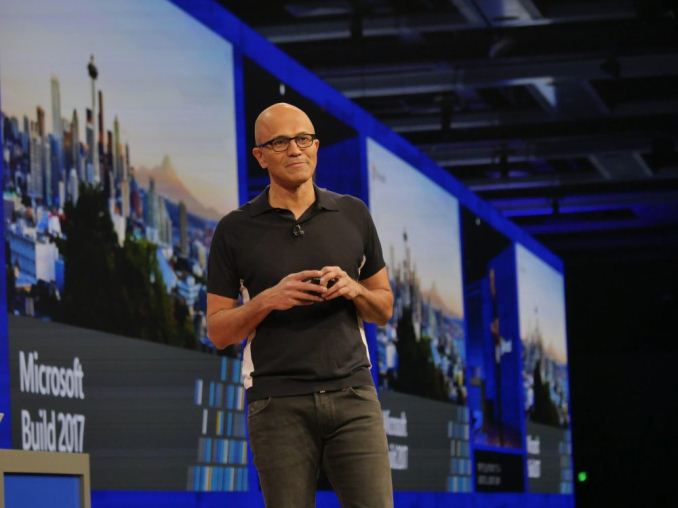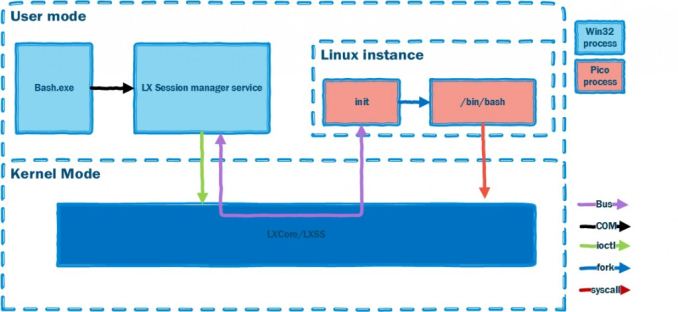The Microsoft Build 2017 Recap: What To Expect When You’re Expecting Windows
by Brett Howse on May 19, 2017 8:00 AM EST
Microsoft’s Build conference is one of their most important shows of the year, with a developer focused discussion that provides some guidance on the direction of Microsoft and its platforms. Over the last couple of years, the platforms have been some of the bigger talking points as well, with Microsoft diversifying across new technologies and markets to try and stay ahead of the curve. Microsoft has predominantly been a platform company over the years, and it’s a rare product they release that doesn’t end up as a platform of some kind. Over the years, the focus on some platforms has had to adjust in order to keep up with the times, and that’s not always an easy goal to accomplish when your original platform, Windows, has been so successful since its inception.
Microsoft had quite a bit of forward leaning news to announce at Build, which we will go over to shed some light on where the company is heading. The company has changed course with their mobile platform never gaining the traction they hoped, and although they have been very successful building out their cloud platforms, for many it’s the consumer facing products that are the most interesting.
Windows 10 Fall Creators Update
Possibly some of the biggest news about Windows actually got announced on April 20, when Microsoft committed to biannual updates for their operating system. This was a welcome announcement, and while some people would argue that it is still too often, when such a large portion of their install base is business, the almost random update interval that came with Windows 10 was unsustainable. IT needs a chance to schedule testing and deployment, and when you have randomly scheduled semi-major updates to the OS, that can be a burden. Having it set in stone for spring and fall should be a much more manageable process, especially since Windows Update for Business will allow them to defer if necessary.
The first big news was a name for the next update to Windows 10, which Microsoft is calling the Fall Creators Update. Perhaps that means the Creators Update should be prefixed with Spring, but the release date and announcement was not unexpected. After the Creators Update arrived with less major changes, and more smaller updates, perhaps there was an expectation that Windows 10 would move to more smaller updates, but the Fall Creators Update looks to be packed with new features.
With the Fall update, Microsoft is looking to refresh the experience again. They are introducing a new experience called Fluent Design, and it appears to be a solid overhaul of the design language for Windows.
Microsoft is also looking to branch out beyond their platform in new ways, with a big push for Cortana and the Microsoft Graph to enable portable experiences across platforms. It’s a smart play when you consider what happened with mobile, and all powered by the cloud.
The Windows Store got a lot of attention, and arguably it’s the part of Windows 10 that needs the most work, especially with the announcement of Windows 10 S where only Store apps will be able to be installed. The Desktop Bridge for Windows has some interesting new customers, and UWP got a lot more API support.
The big surprise at last year’s Build conference was arguable the introduction of the Windows Subsystem for Linux, and that got some more discussion at this conference as well. That, coupled with the new development tools, makes Windows a powerful development platform for much more than just Windows.
As always, it was a busy conference, with plenty of announcements. It’s always exciting to see where the different tech companies try to move the industry, and in what they prioritize in any given year, so let’s dig into the Build conference.













85 Comments
View All Comments
close - Friday, May 19, 2017 - link
I'd guess you're not using Enterprise. The "test this app" experience might be MS's way of steering businesses towards Enterprise rather than Pro.Sivar - Friday, May 19, 2017 - link
I suspect the downloads are done by some third-party software.SaolDan - Friday, May 19, 2017 - link
I second thisclose - Saturday, May 20, 2017 - link
It's actually something MS included as "a feature". The content delivery manager with the pre-installed apps option. You can disable this in registry or local policy.As far as I know it comes in the Pro versions although some older MSDN Windows Enterprise ISOs came with it enables. I guess MS received enough feedback from enterprises to cut the crap so now they just try it on regular customers.
blakflag - Friday, May 19, 2017 - link
I would love it if all my apps could be fetched through the store. The problem is most of them are NOT UWP, and created by small developers (utilities and such). Hopefully MS has made it really easy to get apps into the store, because otherwise most of my apps will never be there.Meteor2 - Saturday, May 20, 2017 - link
I probable have 4-5 programmes beyond Chrome and Office, all but one open source, and none came through the app store. The App Store itself is mainly full of junk.blakflag - Sunday, May 21, 2017 - link
Yeah I know it is. I just wish it weren't. :) I actually find Chocolatey to be pretty useful for open source stuff, although I worry a lot about someone uploading a trojan package since it's much newer and less popular than Ubuntu repository for instance.blakflag - Friday, May 19, 2017 - link
The Linux subsystem is truly amazing stuff, and I already find it useful. Unfortunately there is no GPU-acceleration which is a buzzkill for me. Trying to learn machine learning techniques on Windows is really painful since the library support is not so great.Eden-K121D - Friday, May 19, 2017 - link
I really hope they follow through Fluent design language,Wide Color gamut, and HDR support.I really don't want my 2017 computer run a UI which looks horrible
BrokenCrayons - Friday, May 19, 2017 - link
I see no point in messing with Linux inside of Windows when I can simply use Linux atop bare metal and get the distro I want the way I prefer to use it. As well, I don't have to deal with always-on, Google-levels-of-creepy Cortana lurking and listening or non-removable OneDrive. The visual activity history is nice, but I'd hope it can be totally disabled. Knowing how MS works these days, probably not and it's likely part of their data mining efforts as they play catchup with Alphabet and others.